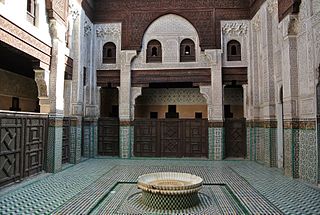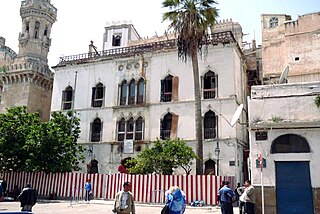
The Ben Youssef Madrasa is an Islamic madrasa (college) in Marrakesh, Morocco. The madrasa is named after the adjacent Ben Youssef Mosque, and was commissioned in 1564–65 CE by the Saadian sultan Abdallah al-Ghalib. Functioning today as a historical site, the Ben Youssef Madrasa was the largest Islamic college in the Maghreb at its height, and is widely recognized as a pinnacle of Saadian and Moroccan architecture.

The Bahia Palace is a mid to late 19th-century palace in Marrakesh, Morocco. The palace was first begun by Si Musa, grand vizier under the Alawi sultan Muhammad ibn Abd al-Rahman, in the 1860s. It was expanded by his son Si Ba Ahmed ibn Musa, grand vizier of Sultan Moulay Abdelaziz, between 1894 and 1900. Today it is a well-known historic monument and tourist attraction in the city.

The Petit Palais is an art museum in the 8th arrondissement of Paris, France.

The Bou Inania Madrasa is a historic madrasa in the city of Meknes, Morocco. The building, well-preserved thanks to later restorations, is considered an excellent example of the richly-decorated madrasas of the Marinid period.

Djamaa el Kebir, also known as the Great Mosque of Algiers, is a historic mosque in Algiers, Algeria. It is located within the Casbah, near the city's harbor. Dating to 1097, it is one of the few remaining examples of Almoravid architecture, although it has undergone other additions and reconstructions since its foundation. It is the oldest mosque in Algiers and is said to be one of the oldest mosques in Algeria after Sidi Okba Mosque and Sidi Ghanem Mosque.

The Bou Inania Madrasa or Bu 'Inaniya Madrasa is a madrasa in Fes, Morocco, built in 1350–55 CE by Abu Inan Faris. It is the only madrasa in Morocco which also functioned as a congregational mosque. It is widely acknowledged as a high point of Marinid architecture and of historic Moroccan architecture generally.

The Al-Attarine Madrasa or Medersa al-Attarine is a madrasa in Fes, Morocco, near the Al-Qarawiyyin Mosque. It was built by the Marinid sultan Uthman II Abu Said in 1323-5. The madrasa takes its name from the Souk al-Attarine, the spice and perfume market. It is considered one of the highest achievements of Marinid architecture due to its rich and harmonious decoration and its efficient use of limited space.

The Bardo National Museum of Prehistory and Ethnography is a national museum located in Algiers, Algeria.

Dar Othman is one of the palaces of the medina of Tunis. The residence is located in the south of the medina, 16 El Mebazaâ Street.

Dar Hassan Pacha is an 18th-century palace located in the Casbah of Algiers, Algeria. It was built in 1791 and used to belong to Hassan III Pasha, who signed a treaty with the US September 5, 1795. After 1830, it became the winter residence of the French Governor of Algiers, and was completely remodelled in 1839, when the entrance was changed and a new façade was added.

Dar Aziza is a 16th-century Moorish palace located in the Casbah of Algiers in Algeria. Today, it houses the National Agency of Archaeology and Protection of Historic Sites and Monuments. Dar Aziza, arguably the most iconic surviving building of its era in Algiers, was part of a large governmental compound known as Janina Palace, which existed before the arrival of Turkish corsairs.

The architecture of Algeria encompasses a diverse history influenced by a number of internal and external forces, including the Roman Empire, Muslim conquest of the Maghreb, French colonization, and movements for Algerian independence.

Dar el Bacha is a palace located in the old medina of Marrakesh, Morocco. It currently houses the Museum of Confluences.

The Lalla Aouda Mosque or Mosque of Lalla 'Awda is a large historic mosque in Meknes, Morocco. It was originally the mosque of the Marinid kasbah (citadel) of the city, built in 1276, but was subsequently remodeled into the royal mosque of the Alaouite sultan Moulay Isma'il's imperial palace in the late 17th century.

Dar Moqri is a historic palace or group of mansions in Fes el-Bali, the old medina of Fes, Morocco. It dates from the late 19th and early 20th centuries and was built by the wealthy and powerful Moqri family. The site is occupied by two grand residences built separately by members of the same family but physically adjoining each other. The older palace was begun by Abdelsalam al-Moqri and probably further modified by his son Muhammad. In addition to its rich interior, it is notable for its large terraced garden. The second palace belonged to his grandson Si Tayb and is notable for its long courtyard which mixes Italianate details with traditional Moroccan decoration. A completely separate palace, known as Riad Driss Moqri, was also built further north by Abdelsalam's son, Si Dris.

The Mausoleum of Moulay Isma'il is a historic Islamic funerary complex in Meknes, Morocco. It contains the tomb of Sultan Moulay Isma'il, who ruled Morocco from 1672 until his death in 1727, and is located inside his former Kasbah (citadel). It is a major historic and religious site in the city.

Dar Ba Mohammed Chergui, also known as Dar al-Aman, is a historic palace or riad-style mansion in the old medina of Fez, Morocco. It is located on Derb el Horra street in Fes el-Bali.

The People's Palace, formerly Palais d'été, is a public building in Algiers. It was first built in the Ottoman era, then became the residence of the Governor of French Algeria, and was the seat of government during the first three years of Independent Algeria (1962-1965). Its current appearance dates to the colonial period.

Dar al-Taj Palace was a palace of the Tunisian Beys, in La Marsa, Tunisia. It is 18 kilometers northeast from Tunis. The palace was constructed as a summer palace and retreat from the capital. It was destroyed in the years after the Tunisian independence. Nothing remains now, except for postcards that serve as reminders of the past glory of the Dar al-Taj.

The Ksar Saïd palace is a former palace of the Tunisian Beys in Le Bardo, a suburb of Tunis, Tunisia. It is close the other major residence of the Husainid dynasty, the Bardo palace. Since 2019, the palace is officially named Ksar Saïd, Palace of Letters and Arts, and is open to the public.





















